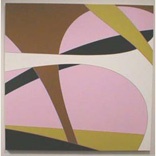It’s a good-looking show.
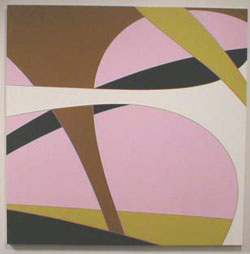
Both artists toy with the decorative function of art, making pleasant, consistent and appealing work that uses a superficial blandness and authoritative craftsmanship to camouflage more complex concerns. Smooth glossy surfaces and updated retro colors make Aaron Parazette‘s paintings the perfect complement to mid-century interior design. Ken Price‘s tabletop clay sculptures play at being vases. Both artists are dangling their feet over the edge of the decorative abyss and whistling innocently.
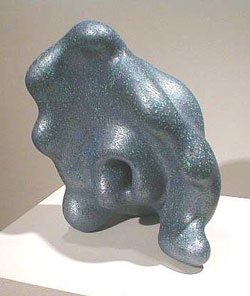
But controlling goo is their passion — Parazette brushing endless layers of glossy enamel, Price molding lumps of squishy clay. Beginning with an amorphous fluid, each arrives at a finely tuned form through laborious primping. The results are paradoxical: images of fluid motion frozen in finicky craft. Both Price and Parazette share a fetishistic love of surface, spending inordinate amounts of loving labor stroking and sanding to get the surfaces they want. The tension between the essentially fluid forms and their rigidly refined execution energizes both artists” work.
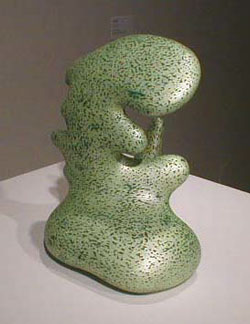
Content-wise, they couldn’t be more dissimilar.
Though abstract, Price’s biomorphs are very anthropomorphic, easily interpreted as cartoon characters in a variety of moods and scenarios. There’s a lot of surrealism in Price’s work; it fits in well with a long tradition of biomorphic blobs impersonating animate characters. Eggs is a striding vaginal ghost. Curvissimo spreads its arms in surprise as it encounters its own erect penile spout. Artists like Arp, Moore, and Tanguy all used similar forms as vehicles for meta-figurative expression, just as Price does, but Price’s blobs are sillier, using colorful metallic finishes and exaggerated, self-consciously dramatic gestures to create a playful, pop-art clownishness unlike the reverent, nature inspired abstractions of Moore or Arp.
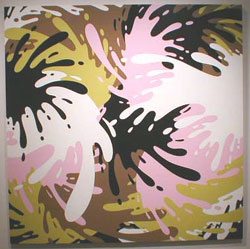
Parazette’s imagery is inorganic: fluid processes of splashing, dripping or stretching have a sense of motion or action, but avoid personality. In Creamy Supreme a network of icy neurons stretch taut across the canvas, in Side Pull, curved splashes of color rotate like a washing machine. Parazette’s Details have a stiffer, more architectural sense of structure. In Detail #1 white black and brown arches span a pink space. Neither the beginning nor end of the gesture is seen in the painting, leaving an impression of static tension rather than movement. Parazette plays colored shapes off one another within the cropped frame of the Detail paintings, assembling crisply outlined shapes like panes in a stained glass window. In an art world overloaded with clever strategies, Material Morph compares a similar approach in the hands of two different artists. The radically different results are a reassuring illustration that art is more than just tactics.
All images courtesy the artists and the Austin Museum of Art.
Bill Davenport is an artist and writer and was one of the first contributors to Glasstire.


